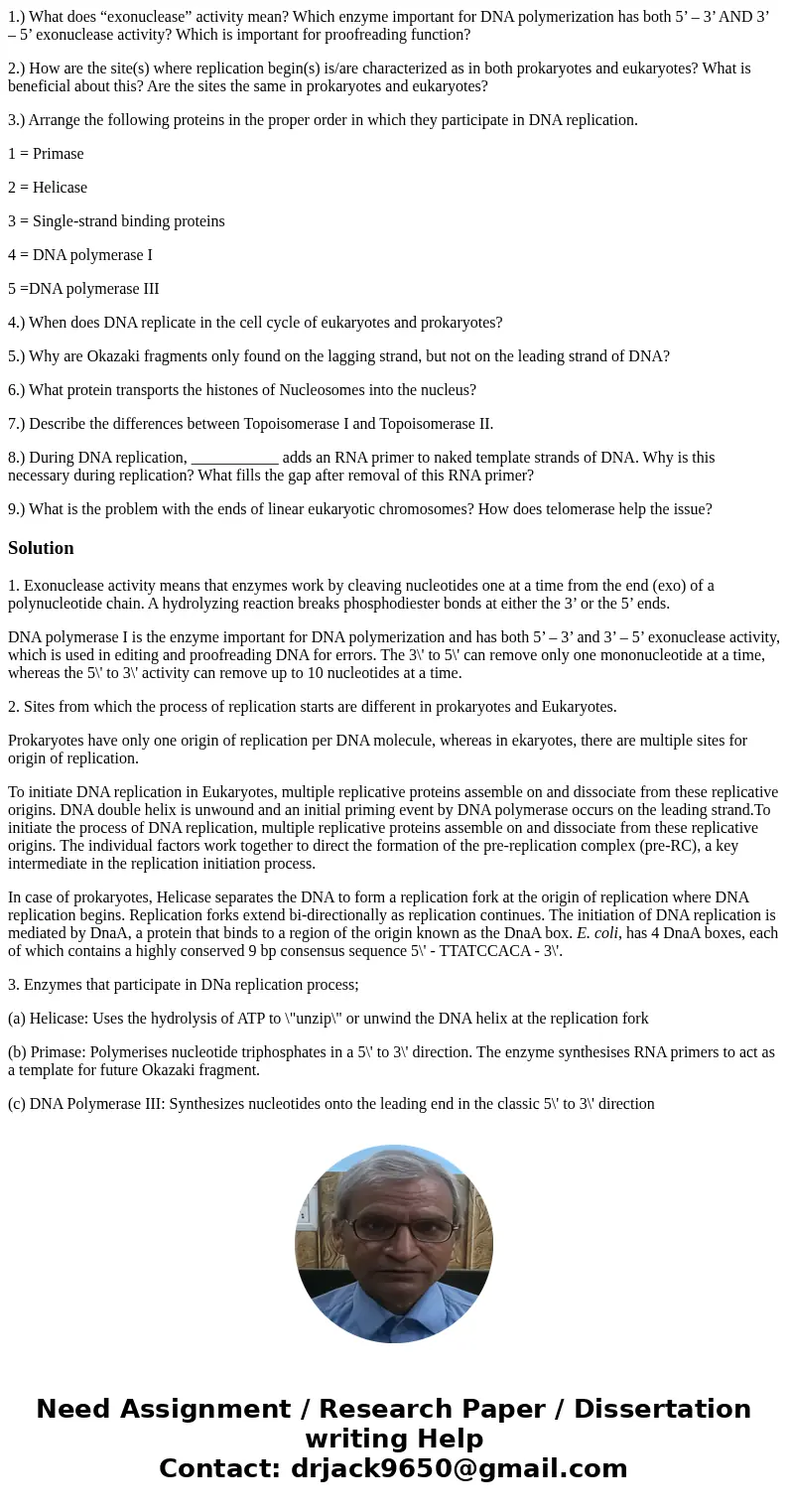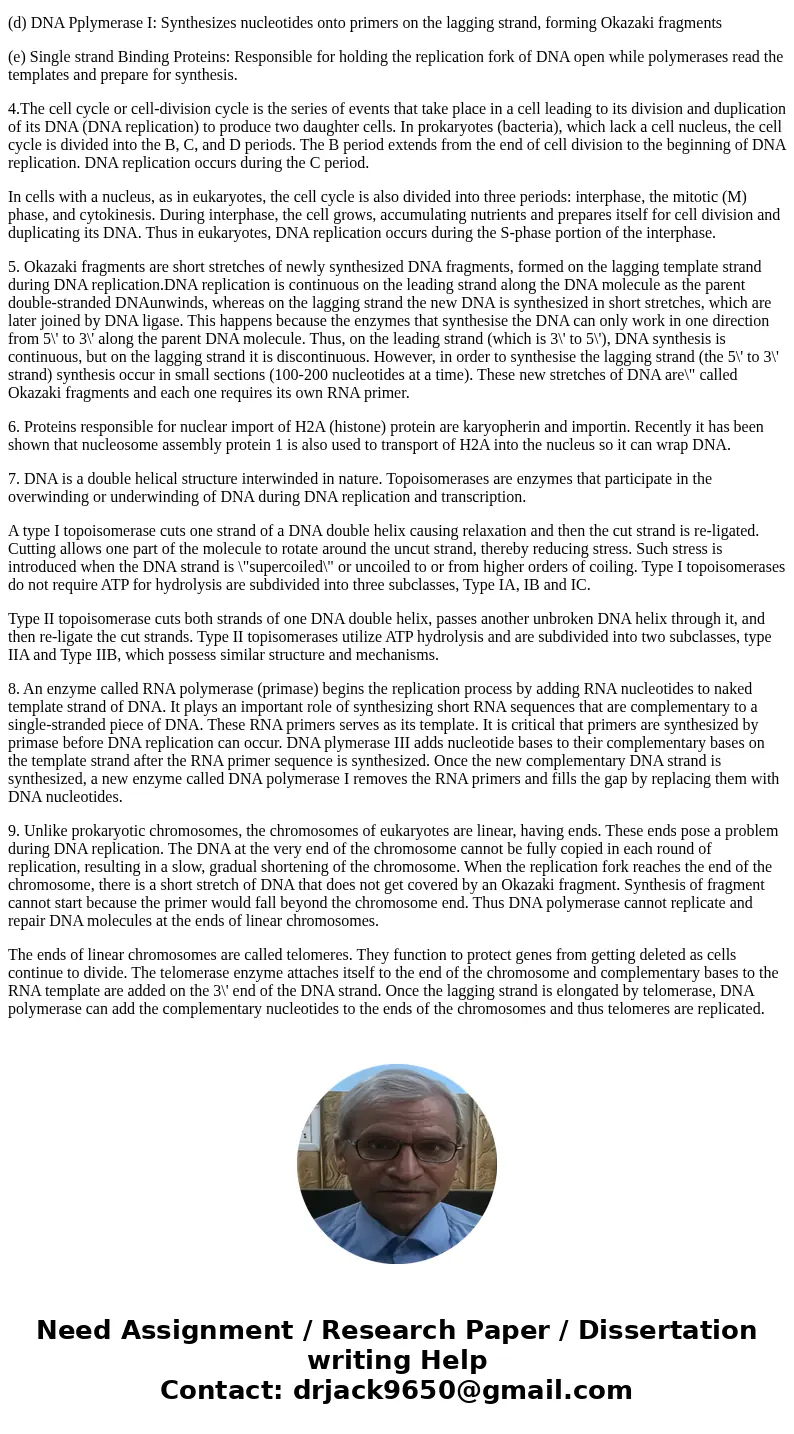1 What does exonuclease activity mean Which enzyme important
1.) What does “exonuclease” activity mean? Which enzyme important for DNA polymerization has both 5’ – 3’ AND 3’ – 5’ exonuclease activity? Which is important for proofreading function?
2.) How are the site(s) where replication begin(s) is/are characterized as in both prokaryotes and eukaryotes? What is beneficial about this? Are the sites the same in prokaryotes and eukaryotes?
3.) Arrange the following proteins in the proper order in which they participate in DNA replication.
1 = Primase
2 = Helicase
3 = Single-strand binding proteins
4 = DNA polymerase I
5 =DNA polymerase III
4.) When does DNA replicate in the cell cycle of eukaryotes and prokaryotes?
5.) Why are Okazaki fragments only found on the lagging strand, but not on the leading strand of DNA?
6.) What protein transports the histones of Nucleosomes into the nucleus?
7.) Describe the differences between Topoisomerase I and Topoisomerase II.
8.) During DNA replication, ___________ adds an RNA primer to naked template strands of DNA. Why is this necessary during replication? What fills the gap after removal of this RNA primer?
9.) What is the problem with the ends of linear eukaryotic chromosomes? How does telomerase help the issue?
Solution
1. Exonuclease activity means that enzymes work by cleaving nucleotides one at a time from the end (exo) of a polynucleotide chain. A hydrolyzing reaction breaks phosphodiester bonds at either the 3’ or the 5’ ends.
DNA polymerase I is the enzyme important for DNA polymerization and has both 5’ – 3’ and 3’ – 5’ exonuclease activity, which is used in editing and proofreading DNA for errors. The 3\' to 5\' can remove only one mononucleotide at a time, whereas the 5\' to 3\' activity can remove up to 10 nucleotides at a time.
2. Sites from which the process of replication starts are different in prokaryotes and Eukaryotes.
Prokaryotes have only one origin of replication per DNA molecule, whereas in ekaryotes, there are multiple sites for origin of replication.
To initiate DNA replication in Eukaryotes, multiple replicative proteins assemble on and dissociate from these replicative origins. DNA double helix is unwound and an initial priming event by DNA polymerase occurs on the leading strand.To initiate the process of DNA replication, multiple replicative proteins assemble on and dissociate from these replicative origins. The individual factors work together to direct the formation of the pre-replication complex (pre-RC), a key intermediate in the replication initiation process.
In case of prokaryotes, Helicase separates the DNA to form a replication fork at the origin of replication where DNA replication begins. Replication forks extend bi-directionally as replication continues. The initiation of DNA replication is mediated by DnaA, a protein that binds to a region of the origin known as the DnaA box. E. coli, has 4 DnaA boxes, each of which contains a highly conserved 9 bp consensus sequence 5\' - TTATCCACA - 3\'.
3. Enzymes that participate in DNa replication process;
(a) Helicase: Uses the hydrolysis of ATP to \"unzip\" or unwind the DNA helix at the replication fork
(b) Primase: Polymerises nucleotide triphosphates in a 5\' to 3\' direction. The enzyme synthesises RNA primers to act as a template for future Okazaki fragment.
(c) DNA Polymerase III: Synthesizes nucleotides onto the leading end in the classic 5\' to 3\' direction
(d) DNA Pplymerase I: Synthesizes nucleotides onto primers on the lagging strand, forming Okazaki fragments
(e) Single strand Binding Proteins: Responsible for holding the replication fork of DNA open while polymerases read the templates and prepare for synthesis.
4.The cell cycle or cell-division cycle is the series of events that take place in a cell leading to its division and duplication of its DNA (DNA replication) to produce two daughter cells. In prokaryotes (bacteria), which lack a cell nucleus, the cell cycle is divided into the B, C, and D periods. The B period extends from the end of cell division to the beginning of DNA replication. DNA replication occurs during the C period.
In cells with a nucleus, as in eukaryotes, the cell cycle is also divided into three periods: interphase, the mitotic (M) phase, and cytokinesis. During interphase, the cell grows, accumulating nutrients and prepares itself for cell division and duplicating its DNA. Thus in eukaryotes, DNA replication occurs during the S-phase portion of the interphase.
5. Okazaki fragments are short stretches of newly synthesized DNA fragments, formed on the lagging template strand during DNA replication.DNA replication is continuous on the leading strand along the DNA molecule as the parent double-stranded DNAunwinds, whereas on the lagging strand the new DNA is synthesized in short stretches, which are later joined by DNA ligase. This happens because the enzymes that synthesise the DNA can only work in one direction from 5\' to 3\' along the parent DNA molecule. Thus, on the leading strand (which is 3\' to 5\'), DNA synthesis is continuous, but on the lagging strand it is discontinuous. However, in order to synthesise the lagging strand (the 5\' to 3\' strand) synthesis occur in small sections (100-200 nucleotides at a time). These new stretches of DNA are\" called Okazaki fragments and each one requires its own RNA primer.
6. Proteins responsible for nuclear import of H2A (histone) protein are karyopherin and importin. Recently it has been shown that nucleosome assembly protein 1 is also used to transport of H2A into the nucleus so it can wrap DNA.
7. DNA is a double helical structure interwinded in nature. Topoisomerases are enzymes that participate in the overwinding or underwinding of DNA during DNA replication and transcription.
A type I topoisomerase cuts one strand of a DNA double helix causing relaxation and then the cut strand is re-ligated. Cutting allows one part of the molecule to rotate around the uncut strand, thereby reducing stress. Such stress is introduced when the DNA strand is \"supercoiled\" or uncoiled to or from higher orders of coiling. Type I topoisomerases do not require ATP for hydrolysis are subdivided into three subclasses, Type IA, IB and IC.
Type II topoisomerase cuts both strands of one DNA double helix, passes another unbroken DNA helix through it, and then re-ligate the cut strands. Type II topisomerases utilize ATP hydrolysis and are subdivided into two subclasses, type IIA and Type IIB, which possess similar structure and mechanisms.
8. An enzyme called RNA polymerase (primase) begins the replication process by adding RNA nucleotides to naked template strand of DNA. It plays an important role of synthesizing short RNA sequences that are complementary to a single-stranded piece of DNA. These RNA primers serves as its template. It is critical that primers are synthesized by primase before DNA replication can occur. DNA plymerase III adds nucleotide bases to their complementary bases on the template strand after the RNA primer sequence is synthesized. Once the new complementary DNA strand is synthesized, a new enzyme called DNA polymerase I removes the RNA primers and fills the gap by replacing them with DNA nucleotides.
9. Unlike prokaryotic chromosomes, the chromosomes of eukaryotes are linear, having ends. These ends pose a problem during DNA replication. The DNA at the very end of the chromosome cannot be fully copied in each round of replication, resulting in a slow, gradual shortening of the chromosome. When the replication fork reaches the end of the chromosome, there is a short stretch of DNA that does not get covered by an Okazaki fragment. Synthesis of fragment cannot start because the primer would fall beyond the chromosome end. Thus DNA polymerase cannot replicate and repair DNA molecules at the ends of linear chromosomes.
The ends of linear chromosomes are called telomeres. They function to protect genes from getting deleted as cells continue to divide. The telomerase enzyme attaches itself to the end of the chromosome and complementary bases to the RNA template are added on the 3\' end of the DNA strand. Once the lagging strand is elongated by telomerase, DNA polymerase can add the complementary nucleotides to the ends of the chromosomes and thus telomeres are replicated.


 Homework Sourse
Homework Sourse